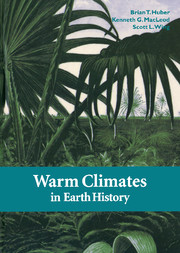Book contents
- Frontmatter
- Contents
- List of contributors
- Preface
- Part 1 Approaches to the study of paleoclimates
- Part II Case studies: latest Paleocene–early Eocene
- Part III Case studies: Mesozoic
- 8 Paleontological and geochemical constraints on the deep ocean during the Cretaceous greenhouse interval
- 9 Late Cretaceous climate, vegetation, and ocean interactions
- 10 Jurassic phytogeography and climates: new data and model comparisons
- Part IV Case studies: Paleozoic
- Part V Overview: climate across tectonic timescales
- Index
- Plate section
8 - Paleontological and geochemical constraints on the deep ocean during the Cretaceous greenhouse interval
from Part III - Case studies: Mesozoic
Published online by Cambridge University Press: 06 July 2010
- Frontmatter
- Contents
- List of contributors
- Preface
- Part 1 Approaches to the study of paleoclimates
- Part II Case studies: latest Paleocene–early Eocene
- Part III Case studies: Mesozoic
- 8 Paleontological and geochemical constraints on the deep ocean during the Cretaceous greenhouse interval
- 9 Late Cretaceous climate, vegetation, and ocean interactions
- 10 Jurassic phytogeography and climates: new data and model comparisons
- Part IV Case studies: Paleozoic
- Part V Overview: climate across tectonic timescales
- Index
- Plate section
Summary
ABSTRACT
For intervals of global warmth, poleward heat transport by warm, saline water masses may be a critical variable in the global climate equation and is widely discussed as a potential mechanism to reconcile differences between computer models and empirical data. However, ocean structure during greenhouse times is poorly constrained, especially on a global scale. The distribution of fossil organisms provides one way to map deep ocean conditions. Inoceramid bivalves reached the acme of their 200 million year range during the Late Cretaceous and then virtually disappeared ∽ 67 million years ago in an event associated with the deterioration of the Cretaceous greenhouse climate (e.g., MacLeod et al., 1996). In 1448 samples (73 sites) representing bathyal paleodepths across the last ∽ 45 million years of the Cretaceous, inoceramid abundance is remarkably constant in time (extinction interval excluded) but not in space. In general, inoceramids were common to abundant throughout the Atlantic and Indian oceans but relatively rare in the Pacific. Geochemical studies of two Indian Ocean sites revealed changes in the δO values of benthic and deep dwelling planktic foraminifers suggesting that bottom waters became cooler and less saline at the time of the inoceramid extinction (MacLeod and Huber, 1996a); new data from a peri-Tethyan site in the western North Atlantic suggest that surface waters became warmer and/or less saline at approximately the same time.
- Type
- Chapter
- Information
- Warm Climates in Earth History , pp. 241 - 274Publisher: Cambridge University PressPrint publication year: 1999
- 3
- Cited by

